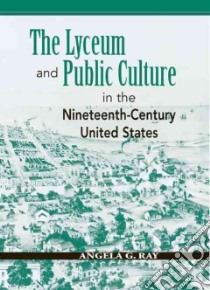The Lyceum And Public Culture In The Nineteenth-Century United States - 9780870137440
Un libro in lingua di Ray Angela G. edito da Michigan State Univ Pr, 2005
- € 22.30
- Il prezzo è variabile in funzione del cambio della valuta d’origine
Angela Ray provides a refreshing new look at the lyceum lecture system as it developed in the United States from the 1820s to the 1880s. She argues that the lyceum contributed to the creation of an American "public" at a time when the country experienced a rapid change in land area, increasing immigration, and a revolution in transportation, communication technology, and social roles.
The history of the lyceum in the nineteenth century illustrates a process of expansion, diffusion, and eventual commercialization. In the late 1820s, a politically and economically dominant culture?the white Protestant northeastern middle class?institutionalized the practice of public debating and public lecturing for education and moral uplift. In the 1820s and 1830s, the lyceum was characterized by organized groups in cities and towns, particularly in the Northeast and the Old Northwest (now the Midwest). These groups were established to promote debate, to create a setting for study, and to provide a forum for members’ lecturing. By the 1840s and 1850s, however, most lyceums concentrated on the sponsorship of public lectures, presented for institutional profit as well as public instruction and entertainment. Eventually, lyceum lectures became a commercial enterprise and desirable platform for celebrities who wished to expand their incomes from lecturing.
Informazioni bibliografiche
- Titolo del Libro in lingua: The Lyceum And Public Culture In The Nineteenth-Century United States
- Autore: Ray Angela G.
- Editore: Michigan State Univ Pr
- Collana: Michigan State Univ Pr (Paperback)
- Data di Pubblicazione: 30 Giugno '05
- Genere: LANGUAGE ARTS and DISCIPLINES
- Argomenti : Lyceums United States History 19th century Popular culture United States History 19th century Lectures and lecturing United States History 19th century
- Pagine: 371
- Dimensioni mm: 222 x 146 x 25
- ISBN-10: 0870137441
- EAN-13: 9780870137440


